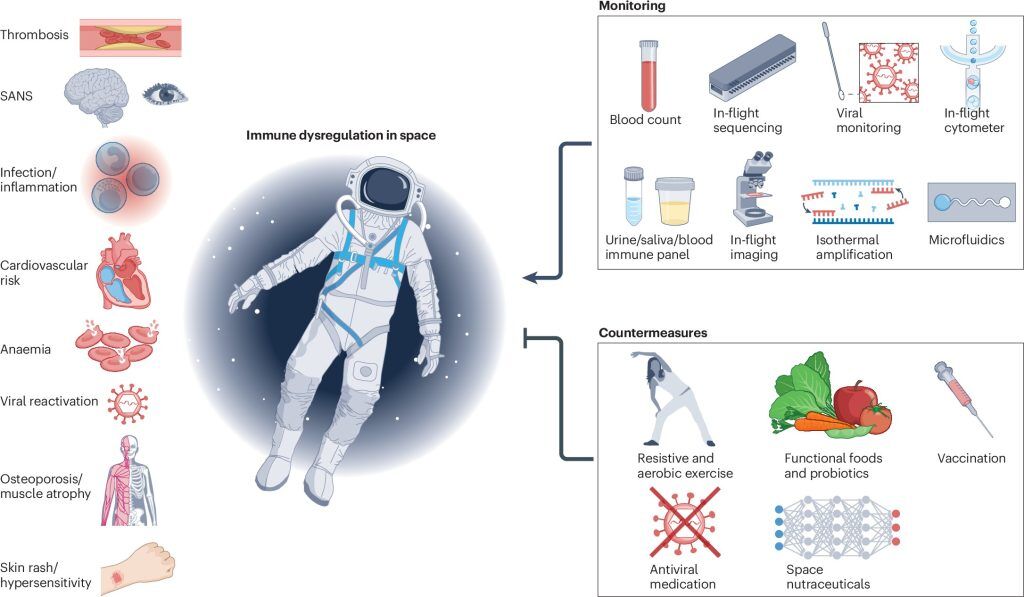New review defines astroimmunology as a lens on how spaceflight accelerates immune decline – and what that means for longevity on Earth.
The immune system, that tireless defender against infection and disease, is not immune to stress itself. When the human body is launched beyond Earth’s atmosphere, immunity falters – astronauts experience skin rashes, viral reactivation and a dampened ability to fight infection. What has long been a matter of clinical observation now has mechanistic explanation, thanks to a sweeping new review published in Nature Reviews Immunology that defines an emerging field: astroimmunology.
Led by Dr Dan Winer of the Buck Institute for Research on Aging, and co-authored with collaborators from NASA, ESA, Cornell University, LMU Munich and others, the paper Astroimmunology: the effects of spaceflight and its associated stressors on the immune system examines decades of data on how spaceflight alters immunity and integrates recent insights from multiomic and in silico analysis. The authors describe how microgravity, radiation and psychological stress collectively perturb immune balance, affecting everything from T-cell activation to mitochondrial metabolism [1].

“The future of humanity will involve living in outer space or on distant worlds for some people,” says Winer. “The larger goal of establishing this emerging subspecialty of astroimmunology is to develop countermeasures to protect the health of those exploring life off Earth.”
Longevity.Technology: Astroimmunology is more than a new branch of space medicine – it’s a natural extension of geroscience into orbit. What this review makes gloriously clear is that the immune system’s response to microgravity, cosmic radiation and stress bears a striking resemblance to its behavior here on Earth as we age; astronauts, in effect, become rapid prototypes for studying immunosenescence. Microgravity unpicks the cytoskeleton, mitochondria splutter, DNA repair falters, and chronic low-grade inflammation simmers away – all rather familiar hallmarks to those who study aging. The difference is that these processes unfold in days rather than decades, providing a compressed view of decline that could accelerate our understanding of how to preserve immune resilience both in space and at home.
That this research sits at the intersection of space biology, systems immunology and longevity biotech is no coincidence; the new ‘astroimmunology’ framework captures the spirit of translational science at its most ambitious. Space is forcing us to confront biology’s limits – and to innovate countermeasures, from AI-identified nutraceuticals such as quercetin to precision immune monitoring and biobanking on a planetary scale. As we ready ourselves for the Moon, Mars and beyond, these insights remind us that the frontiers of space and aging are curiously entwined; the same science that keeps astronauts healthy in orbit may one day keep the rest of us younger for longer.
Mechanisms under pressure
In orbit, gravity’s near-absence reverberates down to the cellular level. The review details how microgravity disrupts immune cell morphology, cytoskeletal integrity and mitochondrial efficiency, culminating in a low-grade inflammatory state coupled with diminished adaptive responses. T-cells become sluggish, interferon signaling wanes and oxidative stress rises. Radiation adds another layer of injury – damaging DNA directly and indirectly through free radicals – while chronic stress and disrupted circadian rhythms further compromise immune regulation.
According to the authors, “spaceflight imparts some basal form of low-grade inflammation coupled to reduced immune cell functionality,” with microgravity inducing cytoskeletal rearrangements that alter nuclear architecture and gene expression [1]. It is, in essence, a perfect storm of physical and psychological stressors acting on cellular machinery adapted to 1g.
Microbes and mission length
Space doesn’t just change us; it changes the microscopic passengers we carry. The paper describes how host–microbiome interactions shift during flight, with reduced microbial diversity and increased virulence. Environmental microbes aboard the International Space Station become more resistant to antibiotics, while astronauts’ gut and skin microbiomes undergo measurable – though often reversible – changes. These microbial shifts are linked to altered immune signaling, reinforcing the idea that immunity and the microbiome form an adaptive unit responding to extraterrestrial stress [1].

Longer missions magnify these issues. Studies from the NASA Twins Project and the SpaceX Inspiration4 mission show that extended time in microgravity amplifies mitochondrial and metabolic dysregulation. “We can now track precisely how each cell of the immune system adapts to space and varied planetary environments, which can guide preparations for new missions and help keep astronauts safe,” says Christopher Mason of Weill Cornell Medicine, a co-author on the review.
Countermeasures and convergence
Winer’s team highlights several strategies to mitigate immune decline in orbit. These include continual immune monitoring, targeted vaccination schedules, and nutraceutical interventions identified through AI modeling – among them quercetin, which may help normalize immune function in simulated microgravity. The authors propose that “integrated multiomic analyses, supported by computational prediction and machine learning, will enable rational design of countermeasures tailored to individual immune phenotypes [1].”
Such precision medicine thinking aligns space biology with the goals of longevity research – maintaining immune resilience as a determinant of healthspan. Huixun Du, lead author and recent Buck PhD graduate, sees the connection clearly. “Spaceflight is an excellent model for accelerated aging,” she says. “Mitochondria don’t work as efficiently in space and start producing free radicals. These same processes happen with aging.” She adds, “Studying this phenomenon in space could jumpstart efforts aimed at keeping our cells healthy as we age.”
Beyond Earthly limits
Astroimmunology is still young, but its implications reach far beyond spaceflight. The establishment of biobanking programs such as the Cornell Aerospace Medicine Biobank and ESA’s Stress and Immunity initiative reflects a growing recognition that astronaut health data are a goldmine for understanding human biology under duress. The same systems biology tools used to map space-induced immune changes are now reshaping how we study aging and resilience on Earth.
As Winer notes, “It’s an exciting time to be involved in space research.” Exciting, yes – but also illuminating. Space, it seems, is not just a destination for exploration; it’s a mirror held up to our own biology, showing us how fragile – and how adaptable – life can be.


